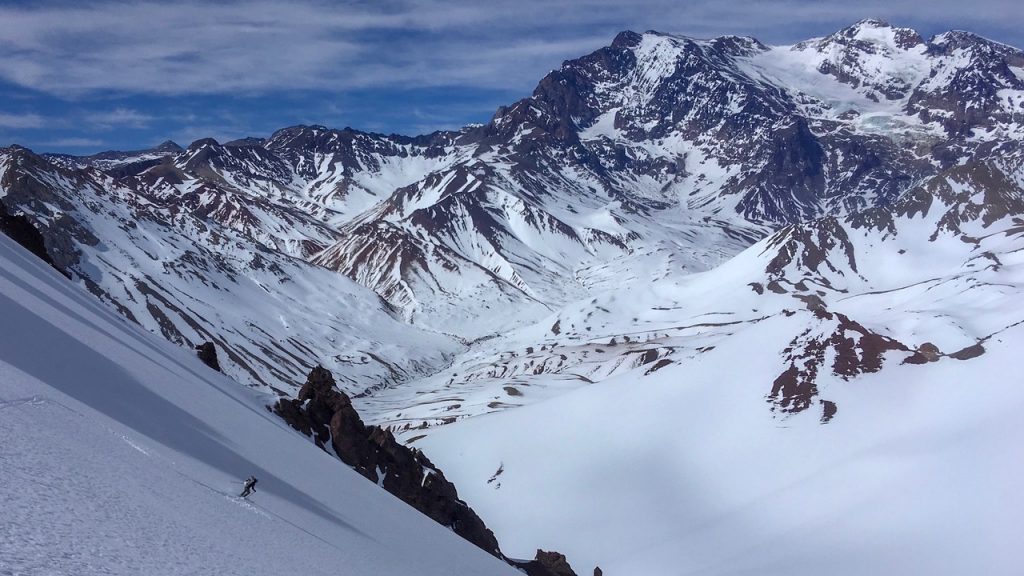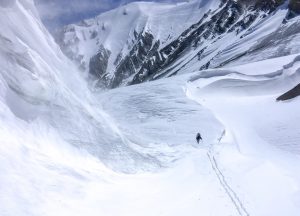My Uphill Athlete coach Sam Naney asked me for some thoughts on persevering with training when a big objective gets nixed or thrown into doubt by circumstances beyond our control. That happened to me last year when a silly but serious injury kept me from the culmination of a multi-year plan to attempt a no Os ascent of and ski descent of Cho Oyu in autumn 2019. And I’m now in the same boat now as everybody else, with my major target for the current ski mountaineering season killed off by the Corona virus situation.
-By Uphill Athlete Dave Riggs
Motivation is personal, and I’m somewhat hesitant to share what follows. My motivation is based on my own core values and my personal experience. These thoughts are mine alone. They may or may not make sense to you, but I hope you can get something from them, even if it’s just the start of your own thinking on the subject.
It’s a cliché, but it could be worse, way worse. For me, it could be a year ago, when I was injured in a way and to an extent that there was the significant possibility that I wouldn’t be able to come back to the level needed for my Cho Oyu objective or perhaps even the everyday mountain pursuits that are an integral part of my life.
In January 2019, things were on track and going well into the final third of my two-year plan for Cho Oyu. In my training, “The sensations were good,” as Sam and I like to joke, and the Training Peaks numbers supported that. (Yeah, I’ll admit it, I like to look at those.) Progressive mini-goals in the mountains were getting done and ramping up. I was stoked.
Then my back starting hurting… bad. Actually sciatic pain from my butt, down my left leg, and into my foot. I’d had some previous mild back issues over the years, so I was not at all panicked. I tried to keep training, but dialed it back. After about two weeks, the pain wasn’t at all tolerable and we concluded that I was damaging myself. There was no traumatic event or moment of “Oh crap. I just threw out my back.” In hindsight, I’m pretty sure that the cause was an intense stretch of days of snow shoveling during an epic storm cycle here in Tahoe. And if you’re wondering whether my training contributed to my injury, it may have, but not in the way you’d think. Sam had me so strong that my ego may have gotten the best of me and made me think I was invincible to the peculiar and vulnerable movements of slinging Sierra Cement over a 4-foot berm.
In September of last year, I had surgery to address a badly herniated disc at L5-S1. That came after eight months of no training and a truckload of PT that, in the end and despite valiant efforts of my therapist, didn’t work. During that time, I experienced some real lows. But looking at my recovery as my training, tracking progress, and trying to just trust the process helped keep those lows from spiraling further downward. I made mini goals that on their face seemed silly. Like progressive PR targets for my daily 30-minute neighborhood walk and perfection of my form in the exercises prescribed by my PT. I worked hard, if not always successfully, on finding reasons to be optimistic and ways to be pragmatic in staying connected to some form of training and the big, long-term goals it was for.
One of my best friends, who was battling cancer at the time, advised me to get my mental game in shape. At Sam’s suggestion, I worked on mindfulness. Although I failed at learning to meditate, I did alter my mindset. My mantra became “This is now, and I’m here. What can I learn?” Gratitude for one. Gratitude for living in the mountains and being able to experience them in ways other than adventure and athletics. How many times do we need to be taught gratitude? For me it’s always one more time.
All the surgeons I eventually consulted said that chances were excellent that the surgery would fix me in a way that would get rid of my pain and allow a return to a “normal” life. But they were decidedly evasive about my prospects for returning to my “uphill athlete” life. Uncertainty. At my six-week check-in after surgery, the doc said “You really shouldn’t bend over for the rest of your life.” I didn’t bother trying to explain to him that bending over is kind of a required movement in skimo. Still uncertain.
On December 1, 2019, after 10 months of injury and recovery from surgery, I was given the OK to resume training. I’m happy to report that I’ve had a great recovery. Sam has led me back quickly over the winter to a level way beyond what I expected. A recent week with two 10k days and some steep skiing was a joy in and of itself, but it also gave me confidence that I can again plan and attempt big stuff. I’m still not sure I’ll be able to restore some of my previous capabilities, like handling the volume of mountain running I was doing. That nags at me from time to time. We’ll see. But I can move in the mountains, and the lingering doubts are minor.
When I compare the uncertainty I had a year ago to the current uncertainty of the pandemic (only as it pertains to our selfish and societally unimportant goals and training), the common theme is that the mountains will always be there. A year ago for me, it was “the mountains will always be there, but will my body ever be capable again?” Now, it’s “the mountains will always be there, so keep training your body (and your mind) to be ready when we can go to them again.” Plan and train now to execute later is way better than hope now that you can execute later.
For me, motivation that is driven by my core values, rather than any particular goal, is more durable. One of my core values is the process of lifelong learning through challenges and changes. Setting mountain goals and training for them is a key vehicle for that learning process. But the learning I do through training – about me, my capabilities and limitations, and how to improve – is as valuable as the mountain goal at which the training is directed. Don’t get me wrong, not being able to execute against the goal is a major disappointment. But training and goals are adaptable. Through my back injury and recovery, I’m learning that I can adapt my previous goals to what my body will allow me to do. For example, I may go back to targeting more technical objectives at lower altitude for which I’d need to substitute more cragging and gym climbing for the running I’m not sure I can still do. If I can make that adaptation, then adapting to plans and goals being deferred by the pandemic is also doable.
Another of my core values is to manage everyday life challenges like change and uncertainty, with the stability of healthy daily routines. My training is one of those. It’s a practice, the importance of which to me goes way beyond the results it produces that directly tie to any goal in the mountains. It’s an integral part of my life and who I am.
Motivation is mental. And the mental aspect of fitness for the mountains is the most difficult part.
Patience. Perseverance. A good learner. An outlook that blends optimism and pragmatism. These are selected attributes that make a great alpinist. “Chapter 13 – Mental Fitness: The Most Difficult 80 Percent, Training for the New Alpinism, House and Johnston (2014)
I’ve gone on above about patience, especially with uncertainty. And I’ve touched on the value of learning as a motivator, as well as being optimistic and pragmatic. What about perseverance? This one seems like a “duh” to me. It’s so obvious that alpinism and other pursuits of uphill athletes require perseverance. It wasn’t obvious to me that meditation would require such patience and perseverance. Now that I’m past my injury, it’s a challenge I need to get motivated to take on.
When I lived in the Midwest, my climbing friends and I got motivation from the perseverance and commitment required to just be a climber or skier so far away from mountains. Like our willingness to drive 8 hours for a day of single pitch rock or ice climbing or skiing at a hill with 300 feet of vertical. Or discovering a new structure on which we could go “buildering.” Or when our purple Karrimor Haston Alpiniste packs came in the mail and we could fill them with some heavy stuff and endure the crippling boredom of laps on the university’s stadium stairs. We took a sense of pride in the belief (misplaced of course) that we (all four of us) were grittier and more motivated than climbers and skiers who actually lived near mountains. It wasn’t supposed to be easy or make sense. Then everybody would be doing it. It was supposed to be hard and weird. You had to persevere. That was the point. At least that’s what we thought. Low level delusional elitism, but it motivated us.
This pandemic, with all the unexpected changes to our lives and all the continuing uncertainty, is our chance to up our respective mental games. Adapt, don’t quit. This will eventually pass. Be ready for when it does, and in the meantime do what you can with what you have. It will make you better.
Photos by Jed Porter



